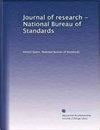History of Trace Analysis
Journal of research of the National Bureau of Standards
Pub Date : 1988-05-01
DOI:10.6028/jres.093.013
引用次数: 10
Abstract
In the era of classical analysis when major and minor constituents of materials such as rocks and ores were determined by gravimetric and titrimetric methods, a measure of the quality of an analysis was the closeness to which the summation of constituents approached 100%. Trace constituents were considered to be those known to be present but in amounts so small that they made no appreciable contribution to the summation. An early authority was Hillebrand [1], who in 1919 wrote his classic book "Analysis of Silicate and Carbonate Rocks" and used the word "trace" to designate constituents present below the limit of quantitative determination, which meant below 0.01 or 0.02 percent. Sandell [2], in his 1944 book "Colorimetric Determination of Traces of Metals," considered major constituents to be those present in amounts greater than 1%, minor constituents to be those present in amounts between 0.01 and 1%, and trace constituents those below 0.01%. The modern definition of "trace" is more flexible, as illustrated by a quotation from a 1965 book, "Trace Analysis" edited by George Morrision [3]: "The connotation of the term "trace" varies with the background or interests of the reader." In that book, the upper limit was considered to be about 100 ppm by weight, and the term "ultratrace" was used for constituents below 1 ppm. To quote further, "any sharp division is, of course, superfluous, and will depend on the nature of the sample to be analyzed, the analytical technique employed, and the analyst." For trace analysis to emerge as a specialty in its own right, two conditions had to be met: specific needs and applicable methods. Qualitative methods in general emerged much earlier than quantitative ones. Quite a few qualitative tests and even a few quantitative methods of great sensitivity existed before the turn of the century, but they remained largely unused as interesting curiosities until a need arose. The decade of the 1940s represented a watershed in creating a variety of new demands for analytical methods of exceptional sensitivity and difficulty. World War II had quite a stimulating effect with respect to new needs, but it also stifled free publication for several years, with the result that shortly after the end of the war in 1945, there was a release of enormous amounts of previously classified material for publication. Methods and instrumentation developed to solve specific problems now became available for wider application. It is now convenient to consider five periods in history-(I) antiquity to the beginning of modern chemistry late in the 18th century, (2) late 18th century through the 19th century, (3) the period from 1900 to 1939, (4) the decade of the 1940s, and (5) the period from 1950 to the present.痕量分析的历史
在经典分析的时代,岩石和矿石等材料的主要成分和次要成分是通过重量法和滴定法确定的,衡量分析质量的一个指标是成分总和接近100%。微量成分被认为是那些已知存在,但数量太少,对总和没有明显贡献的成分。早期的权威是Hillebrand[1],他在1919年撰写了他的经典著作《硅酸盐和碳酸盐岩的分析》,并使用“痕量”一词来指定存在于定量测定限度以下的成分,即低于0.01%或0.02%。桑德尔在他1944年出版的《痕量金属比色法测定》一书中认为,主要成分是指含量大于1%的成分,次要成分是指含量在0.01到1%之间的成分,微量成分是指含量低于0.01%的成分。“痕量”的现代定义更加灵活,正如1965年乔治·莫里森(George Morrision)编辑的《痕量分析》(trace Analysis)中的一段话所示:“‘痕量’一词的内涵随着读者的背景或兴趣而变化。”在那本书中,上限被认为是100百万分之重,“超痕量”一词用于低于1ppm的成分。进一步引用,“当然,任何尖锐的划分都是多余的,这将取决于待分析样本的性质、所采用的分析技术和分析人员。”为了使痕量分析成为一门独立的专业,必须满足两个条件:特定的需求和适用的方法。定性方法的出现一般要比定量方法早得多。在世纪之交之前,已经有了相当多的定性试验,甚至还有一些灵敏度很高的定量方法,但直到需要的时候,它们大都被当作有趣的奇珍异宝使用。20世纪40年代是一个分水岭,它创造了对异常敏感和困难的分析方法的各种新要求。第二次世界大战在新需求方面产生了相当大的刺激作用,但它也抑制了几年的自由出版,其结果是,1945年战争结束后不久,大量以前保密的材料被释放出来供出版。为解决具体问题而开发的方法和仪器现在可以得到更广泛的应用。现在考虑历史上的五个时期是方便的——(1)古代到18世纪末现代化学开始的时期,(2)18世纪末到19世纪,(3)1900年到1939年,(4)20世纪40年代的十年,(5)1950年到现在。
本文章由计算机程序翻译,如有差异,请以英文原文为准。
求助全文
约1分钟内获得全文
求助全文

 求助内容:
求助内容: 应助结果提醒方式:
应助结果提醒方式:


